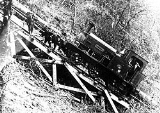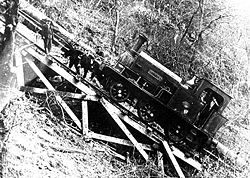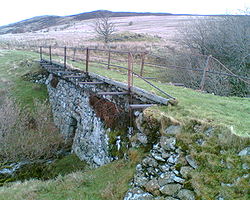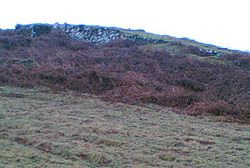
Eigiau Tramway
Encyclopedia
The Eigiau Tramway might refer to the Eigiau Quarry Tramway or to the Eigiau Reservoir Tramway.




in north Wales
. The tramway was an extension of the 4 miles (6.4 km) Cedryn Quarry Tramway
, operating from c1860 to serve the Cedryn slate quarry (SH719636), a little to the south-west of Llyn Eigiau
. The tramway linked these two quarries to Dolgarrog
in the Conwy valley.
In 1861 the North Wales Chronicle referred to "Tenders invited to construct a tram-road 5 miles (8 km) long from Cwm Eigia [sic] slate quarry to River Conwy". However, the tramway was initially only built as far as Cedryn, and in 1863 the Caernarvon & Denbigh Herald advertised for a contractor to extend west to Cwm Eigiau Quarry. It is entirely possible that the first reference to "Cwm Eigia slate quarry" was in fact a reference to Cedryn, for this quarry was located in Cwm Eigiau.
The mile extension was built some time before 1866, and it is likely that the name "Cwm Eigiau Tramway" became largely synonymous with that of the Cedryn Tramway. Indeed the Caedryn [sic] Slate Quarry Co. Ltd of 1863 became in 1874 the Caedryn [sic] & Cwm Eigiau Slate Co. Ltd, but was dissolved just 11 years later, the slate being of a poor quality.
, built from about 1907 to aid the construction of the dam at Eigiau Reservoir
. After the reservoir was completed the tramway continued in use to aid in maintenance of the reservoir and its associated feedpipes.
In 1916, when the narrow gauge Cowlyd Tramway
was begun, this branching off the Eigiau Tramway at the head of the Dolgarrog inclines, the Eigiau Tramway (including the Dolgarrog inclines) was relaid to narrow gauge.
A breach of the dam on November 2, 1925, resulting in the death of 16 Dolgarrog villagers, effectively spelt the end of the tramway, although a small extension was built in that year to aid the reconstruction of Coedty Dam, which also broke. Use of the Cowlyd tramway continued.
, though at Pwll Du, about half a mile above Coedty reservoir
, a small northerly diversion was made in order to avoid a former small incline.
Below Coedty a series of steep inclines ran through Dolgarrog woods down to Dolgarrog. Formerly used to lower the quarry output, they were later used to haul materials for building the dam, and also for hauling steam engines up to the more level part of the tramway. Other than the highest incline, these inclines are now used by two very visible water pipes.
Today, whilst the line of the tramway can easily be followed, and makes a pleasant walk from Eigiau down to the head of the Dolgarrog inclines, there is no evidence of rails or sleepers of any kind. The loading gauge is quite clearly that of a standard gauge railway, and in places there is evidence of minor embankments, cuttings, and a bridge. Towards Llyn Eigiau the Tramway runs along a level path, though the gradients are greater through the woods immediately above Coedty.
, and a Bagnall 0-4-0ST, Works No.2080 of 1918. Upon completion of the dam, and with only maintenance work being envisaged on both dams, Eigiau was taken off, pending sale,
In 1961, an order was placed by the CEGB to Motor Rail
of Bedford, to replace a Hibberd loco that had been in use. It was works No. 22154 of 1962 weighing 2.5 tons with a 28-30 h.p. 2LB diesel engine which led a charmed and seldom-used existence until removed to the CEGB Llanberis contract in September 1975 in connection with cable-laying; it accompanied some ex-Dolgarrog wagons there.'




Eigiau Quarry Tramway
The Eigiau Quarry Tramway was a narrow gauge mile-long horse-powered tramway which operated from c1863 to c1888 and served the Eigiau slate quarry [ref SH702635], near Llyn EigiauLlyn Eigiau
Llyn Eigiau is a lake on the edge of the Carneddau range of mountains in Snowdonia, North Wales.The name Eigiau is thought to refer to the shoals of fish which once lived here. Early maps refer to it as Llynyga...
in north Wales
North Wales
North Wales is the northernmost unofficial region of Wales. It is bordered to the south by the counties of Ceredigion and Powys in Mid Wales and to the east by the counties of Shropshire in the West Midlands and Cheshire in North West England...
. The tramway was an extension of the 4 miles (6.4 km) Cedryn Quarry Tramway
Cedryn Quarry Tramway
The Cedryn Quarry Tramway was an industrial narrow gauge railway that connected the slate quarries at Cedryn and Cwm Eigiau to the quays at Dolgarrog in the Conwy valley.- History :...
, operating from c1860 to serve the Cedryn slate quarry (SH719636), a little to the south-west of Llyn Eigiau
Llyn Eigiau
Llyn Eigiau is a lake on the edge of the Carneddau range of mountains in Snowdonia, North Wales.The name Eigiau is thought to refer to the shoals of fish which once lived here. Early maps refer to it as Llynyga...
. The tramway linked these two quarries to Dolgarrog
Dolgarrog
Dolgarrog is a small village in the Conwy County Borough in North Wales situated between Llanrwst and Conwy, very close to the Conwy River. The village is well known for its industrial history since the 18th century and the Eigiau dam disaster, which occurred in 1925...
in the Conwy valley.
In 1861 the North Wales Chronicle referred to "Tenders invited to construct a tram-road 5 miles (8 km) long from Cwm Eigia [sic] slate quarry to River Conwy". However, the tramway was initially only built as far as Cedryn, and in 1863 the Caernarvon & Denbigh Herald advertised for a contractor to extend west to Cwm Eigiau Quarry. It is entirely possible that the first reference to "Cwm Eigia slate quarry" was in fact a reference to Cedryn, for this quarry was located in Cwm Eigiau.
The mile extension was built some time before 1866, and it is likely that the name "Cwm Eigiau Tramway" became largely synonymous with that of the Cedryn Tramway. Indeed the Caedryn [sic] Slate Quarry Co. Ltd of 1863 became in 1874 the Caedryn [sic] & Cwm Eigiau Slate Co. Ltd, but was dissolved just 11 years later, the slate being of a poor quality.
Eigiau Reservoir Tramway
The Eigiau Reservoir Tramway was a narrow gauge industrial railwayIndustrial railway
An industrial railway is a type of railway that is not available for public transportation and is used exclusively to serve a particular industrial, logistics or military site...
, built from about 1907 to aid the construction of the dam at Eigiau Reservoir
Llyn Eigiau
Llyn Eigiau is a lake on the edge of the Carneddau range of mountains in Snowdonia, North Wales.The name Eigiau is thought to refer to the shoals of fish which once lived here. Early maps refer to it as Llynyga...
. After the reservoir was completed the tramway continued in use to aid in maintenance of the reservoir and its associated feedpipes.
In 1916, when the narrow gauge Cowlyd Tramway
Cowlyd Tramway
The Cowlyd Tramway was a narrow gauge gauge railway line used to convey men and materials to Llyn Cowlyd Reservoir, near Trefriw in North Wales during the enlargement of the dam, and thereafter for maintenance purposes.-History:...
was begun, this branching off the Eigiau Tramway at the head of the Dolgarrog inclines, the Eigiau Tramway (including the Dolgarrog inclines) was relaid to narrow gauge.
A breach of the dam on November 2, 1925, resulting in the death of 16 Dolgarrog villagers, effectively spelt the end of the tramway, although a small extension was built in that year to aid the reconstruction of Coedty Dam, which also broke. Use of the Cowlyd tramway continued.
Route
The tramway ran from Llyn Eigiau, where temporary lines ran north along the line of the dam (which was ¾ mile in length), down to Dolgarrog. The line was built to standard gauge, and largely utilized the route of the former Cedryn/Eigiau Quarry tramway which ran along the lower slopes of Moel EilioMoel Eilio (Carneddau)
Moel Eilio , is a hill in the eastern Carneddau of northern Wales. It looks very prominent on the approach from the north towards Llanrwst along the Conwy Valley....
, though at Pwll Du, about half a mile above Coedty reservoir
Coedty Reservoir
Coedty Reservoir is a reservoir in Snowdonia, North Wales. It is fed by the waters of Afon Porth-llwyd which flows from Llyn Eigiau. The reservoir lies at a height of , and measures some in size. It contains brown trout....
, a small northerly diversion was made in order to avoid a former small incline.
Below Coedty a series of steep inclines ran through Dolgarrog woods down to Dolgarrog. Formerly used to lower the quarry output, they were later used to haul materials for building the dam, and also for hauling steam engines up to the more level part of the tramway. Other than the highest incline, these inclines are now used by two very visible water pipes.
Today, whilst the line of the tramway can easily be followed, and makes a pleasant walk from Eigiau down to the head of the Dolgarrog inclines, there is no evidence of rails or sleepers of any kind. The loading gauge is quite clearly that of a standard gauge railway, and in places there is evidence of minor embankments, cuttings, and a bridge. Towards Llyn Eigiau the Tramway runs along a level path, though the gradients are greater through the woods immediately above Coedty.
Locomotives
As mentioned above, conversion of the tramway to narrow gauge, i.e. that of the Cowlyd Tramway, enabled the utilization of the same locomotives, though they would have spent much more time on the Cowlyd branch, as Eigiau dam only needed maintenance during the time that Cowlyd dam was being built. Two steam engines are recorded as being used at this time, namely the German built loco Eigiau (Orenstein & Koppel, No. 5668 of 1913, latterly at Penrhyn QuarryPenrhyn Quarry
The Penrhyn Slate Quarry is a slate quarry located near Bethesda in north Wales. At the end of the nineteenth century it was the world's largest slate quarry; the main pit is nearly long and deep, and it was worked by nearly 3,000 quarrymen. It has since been superseded in size by slate quarries...
, and a Bagnall 0-4-0ST, Works No.2080 of 1918. Upon completion of the dam, and with only maintenance work being envisaged on both dams, Eigiau was taken off, pending sale,
In 1961, an order was placed by the CEGB to Motor Rail
Motor Rail
Motor Rail was a British locomotive-building company, based in Bedford. Formed in 1911 as The Motor Rail & Tramcar Co Ltd, they built petrol and diesel engined locomotives, mainly narrow gauge. During World War I over 900 locos were supplied for use on temporary military supply railways...
of Bedford, to replace a Hibberd loco that had been in use. It was works No. 22154 of 1962 weighing 2.5 tons with a 28-30 h.p. 2LB diesel engine which led a charmed and seldom-used existence until removed to the CEGB Llanberis contract in September 1975 in connection with cable-laying; it accompanied some ex-Dolgarrog wagons there.'
See also
- Cedryn Quarry TramwayCedryn Quarry TramwayThe Cedryn Quarry Tramway was an industrial narrow gauge railway that connected the slate quarries at Cedryn and Cwm Eigiau to the quays at Dolgarrog in the Conwy valley.- History :...
- Cowlyd TramwayCowlyd TramwayThe Cowlyd Tramway was a narrow gauge gauge railway line used to convey men and materials to Llyn Cowlyd Reservoir, near Trefriw in North Wales during the enlargement of the dam, and thereafter for maintenance purposes.-History:...
- British industrial narrow gauge railwaysBritish industrial narrow gauge railwaysBritish industrial narrow gauge railways are narrow gauge railways in the United Kingdom and the Isle of Man that were primarily built to serve one or more industries. Some offered passenger services for employees or workmen, but they did not run public passenger trains...

